Thermostat in the socket for domestic heaters: types, device, selection tips
The mood of people, well-being and performance depend on the air temperature in the surrounding space. Its value, comfortable for each person, is very individual. If some people work well at + 18 ° C, then others need at least + 23 ° C.
In such cases, it is convenient to install the thermostat in the outlet for domestic heaters to set the desired temperature mode. The device independently reads the temperature in the room and controls the operation of the heater.
Agree, this is very convenient - you do not have to constantly be distracted by turning the heater on and off. It remains only to choose the optimal thermostat and install it. We will show you how to do it.
To understand the variety of offers, you need to find out the features of the various thermostats, take into account the parameters that determine the practicality of the device and the comfort of operation of the heater. Installation of the thermostat is quite simple, the main thing is to adhere to the installation rules outlined in the article.
The content of the article:
Thermostat: purpose and principle of operation
While in the office, I want nothing to be distracting, and all thoughts were focused only on the work process. To achieve this goal helps the optimum temperature in the room.
Well, if you do not need to bring a warm jumper with you in the cold season to warm up slightly, run to the heater or air conditioner, setting and changing settings. The temperature regulator will help to regulate the room temperature.
Appointment of a domestic temperature controller
It is convenient when the heater is working and does not require additional attention. It is also good when you do not need to turn it off at all, and if it becomes cool in the room, run again and turn it on. Thermostats help to monitor the room temperature. Moreover, the simplest and most popular option among consumers is the outlet.
Outlet, aka thermostat installed in the outlet. This is a device that allows you to achieve the optimum temperature in the house / apartment / office. Via temperature sensor it controls the temperature in a particular room, focusing on indicators set by the user.
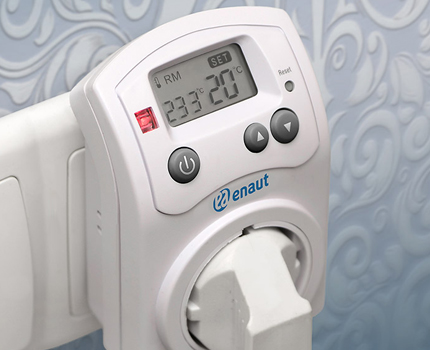
One of the significant advantages of using outlet thermostats is that you do not need to invite a specialist for their installation. Any person who first encounters a device is able to cope with the installation.
The socket thermostat looks like an adapter socket or an overlay. On the reverse side, it has a plug for connecting to the network, and on the front there is a socket into which the plug of the household heater is to be inserted.
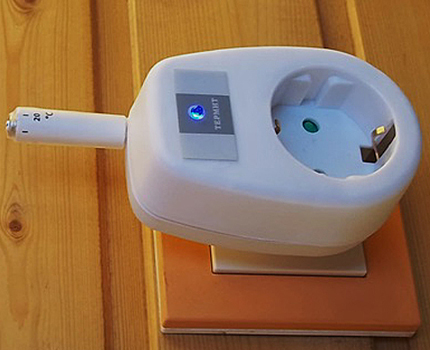
Many models of thermostats can be used not only to control the operation of heating devices, but also for air conditioners, lamps, electric kettles and other equipment powered by electricity. Depending on the type of device, its capabilities differ and, accordingly, the number of settings that can be made.
Features of the outlet thermostat
To get started, you will need to insert the thermostat into a conventional outlet, which will be used to turn on the domestic heater. Its work does not depend on the type of heater, brand and manufacturer. Only one thing is important - that the power of the heater does not exceed the permissible power value for which the thermostat is designed.
Next, you need to set the desired temperature settings for a particular room. Insert the heater plug into the thermostat connector. Everything - the heater will begin to warm the room until the temperature in it reaches the upper limit of the temperature range set by the owner.
The principle of operation of the outlet thermostat is that a special sensor collects information about the temperature around it.If it reaches the lower limit set by the user, then the reaction mechanism is triggered - a relay or a bimetallic plate and the circuit closes.
Accordingly, a heater connected via a thermostat gains access to electricity and begins to work for heating. When the room warms up and its temperature has reached the upper limit of the range set by the owner, the sensor detects this.
The responsive mechanism receives information and closes access to the power grid. If the device is equipped with a bimetallic plate, then it, when heated, opens the circuit itself, and the power supply to the heater is stopped.
According to a similar scheme, the temperature controllers of the warm floor also work. Read more about such devices. here.
And here thermostats for heating radiators operate on a different principle. Such thermal heads are installed directly on the heater.
Video description of the purpose and operation of the Enaut outlet thermostat:
Types of thermostats for heaters
The market is replete with offers for the purchase of temperature controllers. Manufacturers offer such a wide variety of models, among which it is easy to get lost. All devices differ in appearance, color, material used for production, functions performed, type of settings, cost.
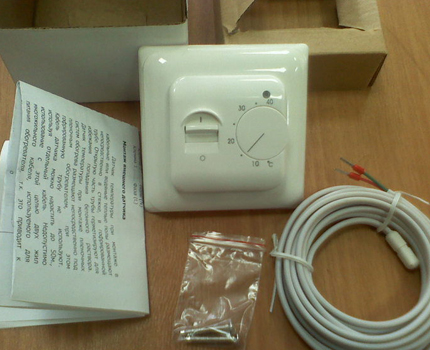
Depending on the type of installation, thermostats are divided into two types:
- stationary - the device is installed in the wall, connecting to the wiring;
- portable or outlet - can be freely carried and used in any room.
A large thermostat installed in the outlet is in great demand among buyers. Easy to connect, configure and use conquers many potential customers.
After all, by connecting the heater through a thermostat outlet and setting the mode of operation for a week, you can safely go on a business trip. All plants will be in comfortable conditions, and the electricity bill will not scare.
According to the type of location of the temperature sensors, thermostats are divided into:
- remote sensor models;
- thermostats with integrated sensor.
The remote sensor is usually located at the end of the cable connected to the controller itself. The length of the wire can be very different - both short and quite impressive. Most often, there are models with a long cable from 1.5 m to 3 m and with a short cable from 10 cm to 20 cm.
By design features there are such types of temperature controllers:
- mechanical;
- electronic;
- GSM managed;
- Wi-fi adjustable.
Mechanical models
Such thermostats are considered the simplest and most affordable. In them, the bimetallic plate serves as the main reacting element. Adjustment and settings of the device are carried out using a lever or a rotary wheel.
The main difficulty lies in the installation - mechanical models are installed in the wall and connected to the supply wire. Because of this feature, many potential customers who do not have experience in installing electrical equipment and related tools refuse mechanical models.
Electronic thermostats
Work thanks to the presence of an electronic circuit. It consists of a sensor, an output relay, overhead / touch control buttons, sometimes a rotary wheel, a microprocessor that processes input commands and issues signals, a thermometer (resistive sensor) that measures temperature.
This type of controller has a monitor that displays setpoint temperatures. To power electronic thermostats need 24 V.
Among them there are programmable models in which you can configure different operating modes - for day, night, day off, work, for a week. Such electronic temperature controllers can work from the built-in, from the remote or from two temperature sensors together.
An increase in temperature reduces the resistance of the sensor, at a certain moment when the critical set temperature is reached, the thermostat trips and opens the circuit - the heater turns off. And vice versa.
GSM managed controllers
Devices allow you to send commands from anywhere in the city. The main thing is that there should be mobile communication at the installation site of the outlet thermostat and at the location of its owner. For their work, a SIM card of a mobile operator is required, which is installed in a special controller slot.
Most often, many GSM-controlled devices have very extensive capabilities, allowing you to control not only the air temperature in the house, but also the inclusion of a boiler, coffee maker, electric kettle or other devices. The main disadvantage of these models is the cost, which can reach quite high limits.
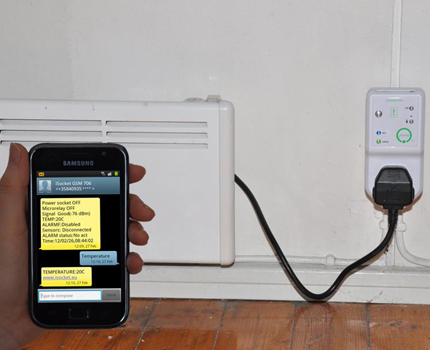
Portable GSM control devices install to ordinary sockets, after replenishing the account and activating a new SIM card.
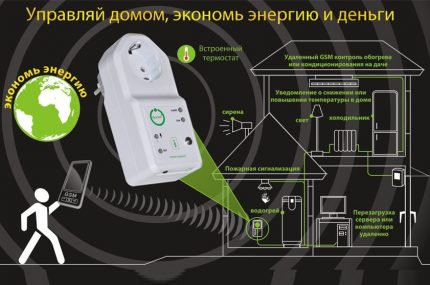
Demonstration of the operation of a smart device - a GSM socket thermostat:
Wi-Fi adjustable thermostats
Expensive and multifunctional outlet thermostats. Many of them can be controlled both via SMS messages and calls, and using the Internet. A prerequisite is the presence of Wi-Fi connection in the house.
The nuances of choosing a thermostat
Having decided on the purchase of a socket thermostat to control the operation of a domestic heater, it is necessary to choose the right model. After all, it is important that the purchase fully satisfies all the requirements and wishes of the buyer.
The market for temperature controllers installed in a socket is replete with a variety of models. For the first time faced with the need for this kind of purchase, you must first determine what criteria the device must meet. The cost will directly depend on the requirements presented to it.
FirstlyWhen choosing a controller for your heater, you need to pay attention to the models that control the air temperature. After all, there are devices that monitor the temperature in the heater itself. This option will not allow you to achieve the most comfortable conditions in the desired room.
Secondly, you should consider the power of your heater. It should not exceed the maximum permissible load on the thermostat. Manufacturers most often produce models that can withstand a load of 2 kW, 3 kW, 3.5 kW.
Optimally, if the needs of heating devices are 30% less than indicated in the technical data of the controller.
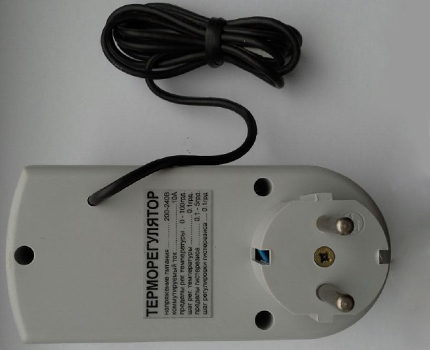
Thirdly, the purpose of the room where you have to install a socket thermostat is important. Each device model has individual technical characteristics, including a range of adjustable temperatures.
Possible values of temperature gradation:
- -5 ° С to + 45 ° С;
- 0 ° C to + 100 ° C;
- -15 ° С to + 30 ° С;
- and other options.
Depending on the purpose of the room, you should choose a thermostat with an appropriate temperature range.
Fourth, you need to decide what other functions the purchased device should have. If he only has to control the operation of the domestic heater, turning it on and off if necessary, then these will be cheaper models.
In the case when you need the option of a thermostat that can receive commands via the Internet and send a report on their implementation, we will talk about a completely different price level. These smart devices, in addition to a programmable temperature regime for each day of the week, are able to control other equipment located in the house.
It is advisable to use models with such capabilities only to control the operation of heating devices in a country house. A couple of hours before arrival, you can send a command about heating the premises to + 19 ° C from your phone or via the Internet.
For the rest of the time when no one is using the cottage, you can set the mode of heating the air in the rooms to + 7 ° C. This temperature will help maintain a comfortable environment for furniture and plants while saving energy.
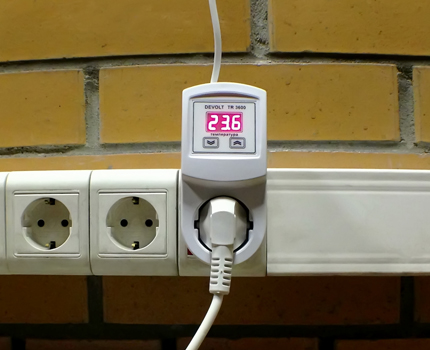
Fifthly, choosing the optimal controller model, you can see that the devices of Western manufacturers are slightly more expensive than domestic counterparts, although the quality of many inexpensive devices is at a high level.
Most often they buy outlet thermostats from manufacturers such as Sardo (China), Deegre, Devolt, Terneo, Tessla, Digitop, Enaut, Hager ek051 (France), Socket other.
At sixth, do not forget about degree of protection of the device (IP). In most cases, it is IP20. Such models are strictly forbidden to use in bathrooms and other rooms with a high level of humidity. For security reasons, for such rooms, you should choose models with a degree of protection IP44 and higher.
An additional criterion for the selection of the thermostat is the color and shape, which will allow it to harmoniously fit into the existing interior of the room. As for size, all offers are compact. There are also models in which a childproof lock is provided.
Correct installation of the temperature controller in the outlet
In order for the purchased controller to fulfill its assigned duties well, it should be installed correctly, taking into account the particular premises. It is also important to set the desired temperature regime, and then he will be able to control the operation of domestic heaters, making it as efficient as possible.
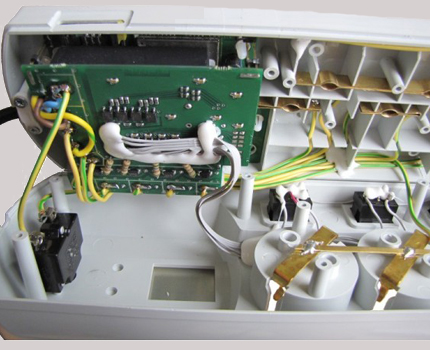
For the correct sensing of the room temperature thermostat by the sensor, it is desirable to install it at a height of 1.2 - 1.5 m from the floor level. It is very good if in the right room there is an outlet located at that level.
Otherwise, you can use a socket temperature controller with an external sensor on a long cable - 1.5-2 m. Such a sensor can be placed in a place convenient for measuring the average air temperature in the room.
Do not place the sensor above or near the heating radiator, by the window or on the windowsill - this will prevent you from getting the correct temperature data.
Only install the device in work outlet. Domestic heaters connected via a temperature regulator must be in good condition. It is important that their power corresponds to the load that a specific controller model can withstand.
Having turned on the thermostat in the socket, you need to make the settings, according to which he will turn on and off the household heater.Depending on the model you purchased, the settings themselves and their number can vary significantly.
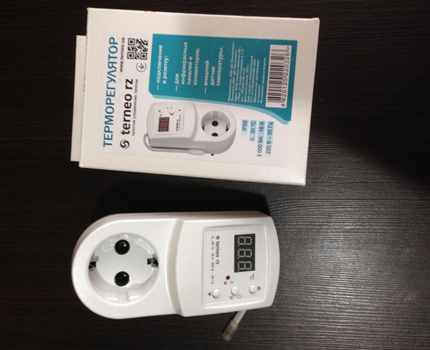
With each device, detailed instructions are necessarily included. It well describes the process of making settings in the device’s memory, its technical characteristics, possible operating modes, as well as the rules for safe operation.
Conclusions and useful video on the topic
Types of temperature regulators and their comparison:
Choosing the optimal model of the thermostat and installing it correctly in the outlet, you can make your life much more comfortable.
Now, in order to maintain the desired temperature in the house / office, you do not have to constantly pay attention to the heater, turning it on and off. The thermostat itself will control this process, taking into account the settings set by the user, which will help to save energy.
Looking for a practical and convenient thermostat for a power outlet? Or have experience using such devices? Please leave comments on the article and share your impressions about the use of thermostats for heaters.

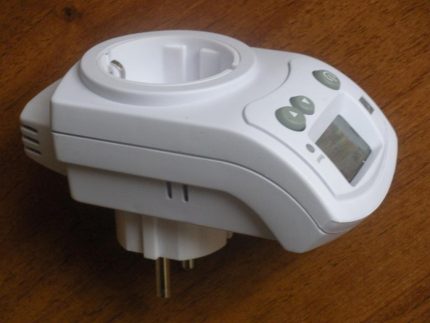
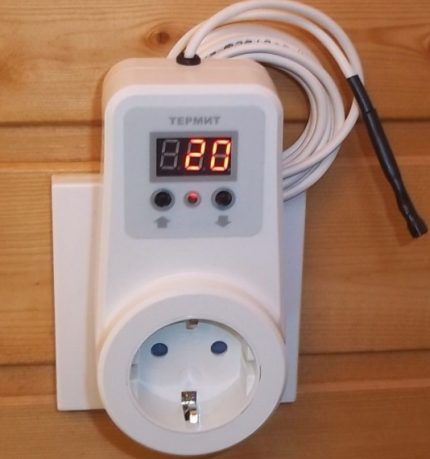
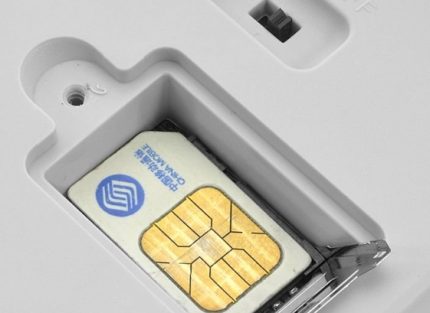
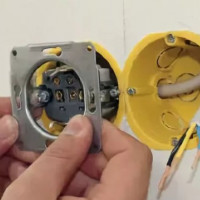 How to install a socket in drywall: installation rules and tips for installing a socket
How to install a socket in drywall: installation rules and tips for installing a socket  Dimmable LED bulbs: selection tips, an overview of the best manufacturers
Dimmable LED bulbs: selection tips, an overview of the best manufacturers 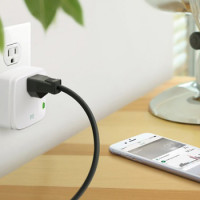 Smart socket with remote control: types, device, how to choose a good one
Smart socket with remote control: types, device, how to choose a good one 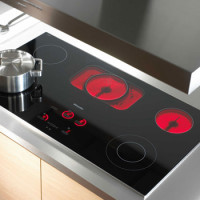 Power socket for an electric stove: types, device, technical standards and connection rules
Power socket for an electric stove: types, device, technical standards and connection rules 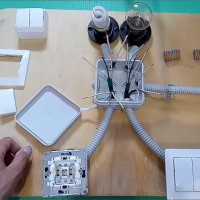 Two-way walk-through switch: device + wiring diagram + installation tips
Two-way walk-through switch: device + wiring diagram + installation tips 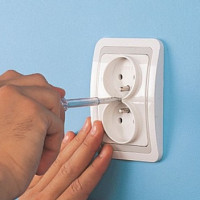 How to connect a double outlet: installing a double outlet in one socket
How to connect a double outlet: installing a double outlet in one socket  How much does it cost to connect gas to a private house: the price of organizing gas supply
How much does it cost to connect gas to a private house: the price of organizing gas supply  The best washing machines with dryer: model rating and customer tips
The best washing machines with dryer: model rating and customer tips  What is the color temperature of light and the nuances of choosing the temperature of the lamps to suit your needs
What is the color temperature of light and the nuances of choosing the temperature of the lamps to suit your needs  Replacement of a geyser in an apartment: replacement paperwork + basic norms and requirements
Replacement of a geyser in an apartment: replacement paperwork + basic norms and requirements
If you buy such a thermostat, then you must definitely take the products of a normal company and of normal quality. To be honest, I am somewhat alarmed by such devices that will independently supply voltage to the device or turn it off. It’s better to immediately buy a heater with a built-in temperature controller. At least one additional device will be less.
Igor, the problem with the built-in regulators is that. that they are located directly on the device. Accordingly, they cannot correctly monitor the room temperature.
Of course, the thing is convenient and all that. But, as mentioned above, it does not inspire confidence, especially in this regard: “Models controlled from a telephone and a computer can be left unattended.” It seems to me impossible to have such a thing in principle, it’s the same device that itself supplies the necessary voltage! And if something goes wrong? There is not a single device that works without interruptions and is absolutely perfect, in my opinion.
Maybe someone has already purchased this device? I would like to read real reviews.
Anastasia, you, apparently, are poorly versed in the concepts of “working devices” and “devices under continuous load”. So, there are electrical appliances that always work. From year to year, day and night. But these sockets are just a bridge between the equipment and the voltage source. That's all! And yet, Anastasia, a huge number of computers work ALWAYS. Among them are those that now allow you to write reviews on sites.